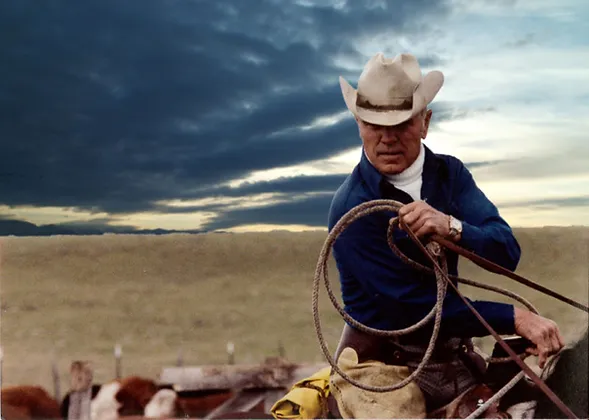Eddie was born to Lithuanian immigrants, Rupert and Elizabeth (Wishwell) Dvarishkis, in Hudson, Wisconsin in 1914. He moved with his parents to Cottonwood, Wyoming, in 1917 where he lived and worked on his mother’s homestead.
After graduating the eighth grade he boarded in Thermopolis working at the Carter Hotel to cover his room and board until he graduated from high school. He attended the University of Wyoming for one semester before dropping out to help put his sister through college. In 1933, at the age of 19, Eddie went to Ernest May, Sr. and applied for work on the Antler Ranch. He spent the rest of his life living on Wood River and working at what he loved doing most. He was the TA (Antler) Ranch Cow Foreman for more than 50 years until he retired in the late 1980’s.
During his years on the Antler Ranch, Eddie saw the life of ranching go through multiple changes as dictated by technology and economics. Always wanting to achieve what was best for the Ranch, Eddie learned and practiced new ways while adhering to proven successful methods of the past. Through years of experience and extensive reading, Eddie became known as a source of information in horse training and cattle management. Many an aspiring young cowboy came to work for him, learned the trade and continued with ranching on their own. In addition to his cow foreman responsibilities, Eddie enjoyed raising registered Quarter horses and had a small herd of Herefords. In recognition of his professionalism the American Quarter Horse Association presented him a Cumulative Breeder for 30 Years Award.
In 1933, when he started cowboying for Wyoming’s Antlers Ranch, headquartered on the Wood River southwest of Meeteetse, he was earning $35 a month, plus room and board. The Antlers Ranch encompassed 40, 000 acres, including 27, 000 deeded acres in addition to state, Forest Service, and BLM leases. As a cowboy on the early-day Antlers Ranch, Eddie’s duties included moving cattle, building and repairing fences, and “riding line” on the yearlings on Cottonwood Creek to keep them within a designated area. “In those days, you could ride from Cottonwood to Thermopolis without running into a fence,” he says. Each cowboy was issued seven head of horses in his string, and with so many cattle to tend and open miles to cover, a cowboy could easily wear out a horse in one day or less. The men worked seven days a week, only getting time off on the Fourth of July, Labor Day, Thanksgiving, and Christmas.
Eddie would bring a packhorse from cow camp to ranch headquarters for groceries at the commissary called the “Red House.” There, a cook fed the cowboys, irrigators, and hay hands, which numbered around 20 men during haying season. Eddie’s groceries consisted mainly of canned goods, as there was no refrigeration at the cow camps, and keeping fresh meat fresh was a challenge. Cowboys at the cow camps cooked for themselves. “Wild game was not plentiful then, and if you saw a deer, it was a topic of conversation for several days. The elimination of wolves in the area caused the game population to explode, and the increase in the deer population offered another source of meat for the cowboys.
In 1941, Eddie married Kathryn Kirkpatrick, the teacher at the nearby one-room Dick Creek School. They had five children; Patrick, Sandi, Kathy, Sylvia, and Mark. The Dvarishkis family lived in the Cheeseman house at the old Antlers Ranch headquarters. In 1963, the Wood River area received over three inches of rain during a storm, and the flooding river undercut the bank, toppling the house into the river, destroying it. Fortunately, no one was injured, but the Dvarishkis family lost many possessions and numerous old photographs. Eddie then purchased the recently vacated Sunshine School house, and extensively remodeled it to make a home for his family.
Eddie retired in 1979, and though he continued to occasionally help on the ranch, he enjoyed his newfound freedom, traveling across the country. Eddie Dvarishkis, 98, died Oct. 19, 2012, living all but the last couple of months of his life on the ranch at Wood River.


